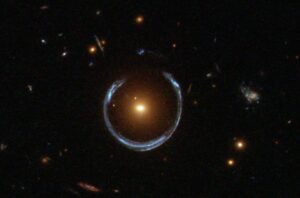How hard would it be to spot an object eight kilometers wide that was also 2.6 billion km away?
Even with the most advanced ground telescopes to ever grace the Earth, it’s an almost inconceivable task. But several researchers pulled it off recently, successfully locating three diminutive new moons orbiting Uranus and Neptune.
“The three newly discovered moons are the faintest ever found around these two ice giant planets using ground-based telescopes,” said Carnegie Science astronomer Scott S. Sheppard in a statement. “It took special image processing to reveal such faint objects.”
Sheppard teamed up with NASA’s Jet Propulsion Laboratory and the University of Hawaii to spot the objects through telescopes in Chile and Hawaii. Confirming the objects required Sheppard and his cohort to layer and compare multiple images captured at both locations over several years.
“By layering these multiple exposures together, stars and galaxies appear with trails behind them, and objects in motion similar to the host planet will be seen as point sources, bringing the moons out from behind the background noise in the images,” Sheppard explained.

S/2023 U1 is the faint point of light in the center of the image. (An arrow points to it in the lower version of the image). The trails are from background stars. Image: Scott Sheppard
Tiny specks make huge orbits
The astronomer first located Uranus’ eight-kilometer S/2023 U1 with the Magellan telescope at Carnegie Science’s Las Campanas Observatory in Chile. “Probably” the smallest of Uranus’ 28 moons, it takes 680 days to orbit the planet.
The two new Neptunian moons proved more stubborn to confirm. In fact, the brighter one once appeared in telescopes as early as 2003 — but astronomers lost it in the abyss before they could establish details.
Now, observations including that first glimpse and dating back to 2021 have finally confirmed it. S/2002 N5 is about 23 kilometers across, and takes almost nine years to orbit the ice giant. The fainter Neptune moon, S/2021 N1, is about 14 kilometers wide with an orbit of nearly 27 years.

The Subaru Telescope, in Mauna Kea, Hawaii, helped locate one very faint moon orbiting Neptune. Photo: Wiki Commons
Each new moon could hold insights into the formation of the Milky Way. They all show distant, non-circular orbits that suggest their host planets captured them not long after the Big Bang, according to Carnegie Science.
The new satellites likely complete Uranus’ and Neptune’s moon inventories. However, astronomers have found moons orbiting Jupiter as small as two kilometers across.
Still designated only by letters and numbers, their permanent names will reflect their planetary pantheons. Uranus’ moons all share names with Shakespeare characters, and Neptune’s are named after the Nereid sea goddesses in Greek mythology.






